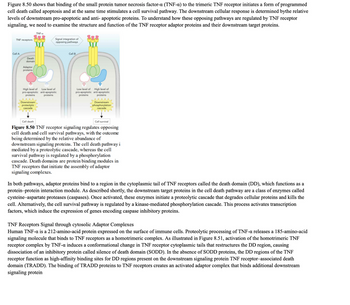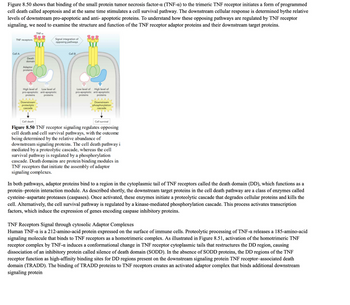
Human Anatomy & Physiology (11th Edition)
11th Edition
ISBN: 9780134580999
Author: Elaine N. Marieb, Katja N. Hoehn
Publisher: PEARSON
expand_more
expand_more
format_list_bulleted
Question
Give an overview of the pathway and what it does, and explain the nature of the TNF ligand and the receptor for that ligand. Make sure to include an explanation of the proteolytic and phosphorylation cascades.

Transcribed Image Text:**TNF Receptor Signaling and Pathways**
**Overview:**
Figure 8.50 illustrates the role of the small protein tumor necrosis factor-α (TNF-α) in regulating both cell death (apoptosis) and cell survival. Upon binding to the trimeric TNF receptor, TNF-α can trigger programmed cell death while simultaneously activating a cell survival pathway. The balance between these pathways is influenced by downstream signaling proteins, which encompass both pro-apoptotic and anti-apoptotic proteins. Understanding this balance requires an examination of the TNF receptor adaptor proteins and their downstream targets.
**Diagram Explanation:**
- **Diagram Title:** Figure 8.50
- **Content:** The diagram portrays TNF receptor signaling involving cell death and survival pathways.
- **Left Side (Cell A):**
- Shows a high level of pro-apoptotic proteins leading to apoptosis.
- Pathway indicated by red arrows, labeled as the proteolytic cascade.
- **Right Side (Cell B):**
- Shows a low level of pro-apoptotic proteins and a high level of anti-apoptotic proteins that result in cell survival.
- Pathway indicated by blue arrows, labeled as the phosphorylation cascade.
**Detailed Explanation:**
- **Adaptor Proteins and Death Domains:**
Adaptor proteins interact with a domain in the TNF receptor’s cytoplasmic tail known as the death domain (DD), which is crucial for protein–protein interactions.
- **Cell Death Pathway:**
Triggered by cysteine–aspartate proteases (caspases), leading to a proteolytic cascade that degrades cellular proteins and induces cell death.
- **Cell Survival Pathway:**
Regulated by kinase-mediated phosphorylation, activating transcription factors that express genes encoding proteins inhibiting apoptosis.
**TNF Receptors and Cytosolic Adaptor Complexes:**
- **Human TNF-α:**
This protein is a 212-amino-acid molecule secreted by immune cells. Its proteolytic processing results in a 185-amino-acid signal that binds to TNF receptors to form a homotrimeric complex.
- **Activation Process:**
- TNF-α binding induces conformational changes in the TNF receptor’s cytoplasmic tails, modifying the DD region.
- This results in the dissociation of the inhibitory protein, silence of death domain (

Transcribed Image Text:**Figure 8.50 Explanation for Educational Website:**
The image illustrates the dual role of TNF receptor signaling in regulating cell death and survival pathways upon binding with the tumor necrosis factor-alpha (TNF-α). When TNF-α binds to the trimeric TNF receptor, it can initiate apoptosis (programmed cell death) or stimulate a survival pathway. The decision between these two outcomes depends on the relative abundance of downstream signaling proteins.
**Diagram Explanation:**
- **Left Side (Apoptosis Pathway):**
- TNF receptors on "Cell A" bind TNF-α.
- Death domains in the receptors activate adaptor proteins.
- High levels of pro-apoptotic proteins are present.
- This leads to a downstream proteolytic cascade, promoting cell death.
- **Right Side (Survival Pathway):**
- TNF receptors on "Cell B" bind TNF-α.
- Adaptor proteins are activated.
- High levels of anti-apoptotic proteins are present.
- This results in a kinase-mediated phosphorylation cascade, promoting cell survival.
**Text Explanation:**
Adaptor proteins bind to the death domain (DD) of TNF receptors, initiating either the cell death or survival pathway. In the apoptosis pathway, caspases degrade cellular proteins, leading to cell death. For cell survival, a kinase-mediated phosphorylation cascade activates transcription factors, promoting the expression of anti-apoptotic genes.
**Signal Transduction:**
TNF-α, a 185-amino-acid signaling protein, binds to TNF receptors. This binding induces conformational changes in the receptor that dissociate the silence of death domain (SODD) proteins, allowing DD regions to bind adaptor proteins. This forms a complex that promotes further downstream signaling, either leading to cell death or survival according to the context of the signaling proteins involved.
Expert Solution
This question has been solved!
Explore an expertly crafted, step-by-step solution for a thorough understanding of key concepts.
Step by stepSolved in 2 steps

Knowledge Booster
Learn more about
Need a deep-dive on the concept behind this application? Look no further. Learn more about this topic, biology and related others by exploring similar questions and additional content below.Similar questions
- Briefly describe how inflammation can contribute to carcinogenesis and disease progression through heterotypic signaling.arrow_forwardDespite the important concerns about fatalities when infected, most people who become sick with COVID-19 have. Mild illness Severe illness Critical illnessarrow_forwardDiscuss the advantages and disadvantages of general chemotherapy like Etoposide compared to specific inhibition of EGFR.arrow_forward
- Write a summary of how our bodies can avoid and treat COVID-19.arrow_forwardBecause of prolonged stress created by the COVID 19 pandemic, many people have experienced adrenal fatigue created by the General Adaptation Syndrome. Please explain, using COVID-19 as an example, what this is and how this process develops into adrenal fatigue or organ collapse. Be sure to explain each stage of GAS and which/how hormones are involved in your answer.arrow_forwardhow does heparin work as an anticoagulant? How does warfarin work as an anticoagulant?arrow_forward
- TCR and CD28 signaling together leads to maximal production of IL-2 by the activated T cell. Experiments investigating the mechanism underlying the CD28 co-stimulation-mediated increase in IL-2 production show that T cells stimulated through the TCR plus CD28 have increased levels of IL-2 mRNA compared to cells stimulated through the TCR alone. One important component contributing to increased IL-2 mRNA levels is increased mRNA stability after transcription and splicing. increased glucose metabolism due to increased production of glycolytic enzymes. increased protein synthesis due to increased production of ribosomes. enhanced mRNA transport from the nucleus to the cytoplasm. 0 0 0 0arrow_forwardAccording to this article whats the role of TNF in Rheumatoid Arthritis. Expand on how the signaling pathway is disrupted in your answer.arrow_forwardBriefly explain the role of acetlycholinesterase inhibitors in impulse transmission processarrow_forward
- Mutations in which of the following would MOST DIRECTLY affect the cAMP signaling pathway? Adenylyl cyclase PKA IP3 Ligand-gated ion channelarrow_forwardExplain the activation of the protein kinase, c-raf, in response to growth factor receptor activationarrow_forwardPlease explain the steps in this pathway on the picture.arrow_forward
arrow_back_ios
SEE MORE QUESTIONS
arrow_forward_ios
Recommended textbooks for you
 Human Anatomy & Physiology (11th Edition)BiologyISBN:9780134580999Author:Elaine N. Marieb, Katja N. HoehnPublisher:PEARSON
Human Anatomy & Physiology (11th Edition)BiologyISBN:9780134580999Author:Elaine N. Marieb, Katja N. HoehnPublisher:PEARSON Biology 2eBiologyISBN:9781947172517Author:Matthew Douglas, Jung Choi, Mary Ann ClarkPublisher:OpenStax
Biology 2eBiologyISBN:9781947172517Author:Matthew Douglas, Jung Choi, Mary Ann ClarkPublisher:OpenStax Anatomy & PhysiologyBiologyISBN:9781259398629Author:McKinley, Michael P., O'loughlin, Valerie Dean, Bidle, Theresa StouterPublisher:Mcgraw Hill Education,
Anatomy & PhysiologyBiologyISBN:9781259398629Author:McKinley, Michael P., O'loughlin, Valerie Dean, Bidle, Theresa StouterPublisher:Mcgraw Hill Education, Molecular Biology of the Cell (Sixth Edition)BiologyISBN:9780815344322Author:Bruce Alberts, Alexander D. Johnson, Julian Lewis, David Morgan, Martin Raff, Keith Roberts, Peter WalterPublisher:W. W. Norton & Company
Molecular Biology of the Cell (Sixth Edition)BiologyISBN:9780815344322Author:Bruce Alberts, Alexander D. Johnson, Julian Lewis, David Morgan, Martin Raff, Keith Roberts, Peter WalterPublisher:W. W. Norton & Company Laboratory Manual For Human Anatomy & PhysiologyBiologyISBN:9781260159363Author:Martin, Terry R., Prentice-craver, CynthiaPublisher:McGraw-Hill Publishing Co.
Laboratory Manual For Human Anatomy & PhysiologyBiologyISBN:9781260159363Author:Martin, Terry R., Prentice-craver, CynthiaPublisher:McGraw-Hill Publishing Co. Inquiry Into Life (16th Edition)BiologyISBN:9781260231700Author:Sylvia S. Mader, Michael WindelspechtPublisher:McGraw Hill Education
Inquiry Into Life (16th Edition)BiologyISBN:9781260231700Author:Sylvia S. Mader, Michael WindelspechtPublisher:McGraw Hill Education

Human Anatomy & Physiology (11th Edition)
Biology
ISBN:9780134580999
Author:Elaine N. Marieb, Katja N. Hoehn
Publisher:PEARSON

Biology 2e
Biology
ISBN:9781947172517
Author:Matthew Douglas, Jung Choi, Mary Ann Clark
Publisher:OpenStax

Anatomy & Physiology
Biology
ISBN:9781259398629
Author:McKinley, Michael P., O'loughlin, Valerie Dean, Bidle, Theresa Stouter
Publisher:Mcgraw Hill Education,

Molecular Biology of the Cell (Sixth Edition)
Biology
ISBN:9780815344322
Author:Bruce Alberts, Alexander D. Johnson, Julian Lewis, David Morgan, Martin Raff, Keith Roberts, Peter Walter
Publisher:W. W. Norton & Company

Laboratory Manual For Human Anatomy & Physiology
Biology
ISBN:9781260159363
Author:Martin, Terry R., Prentice-craver, Cynthia
Publisher:McGraw-Hill Publishing Co.

Inquiry Into Life (16th Edition)
Biology
ISBN:9781260231700
Author:Sylvia S. Mader, Michael Windelspecht
Publisher:McGraw Hill Education